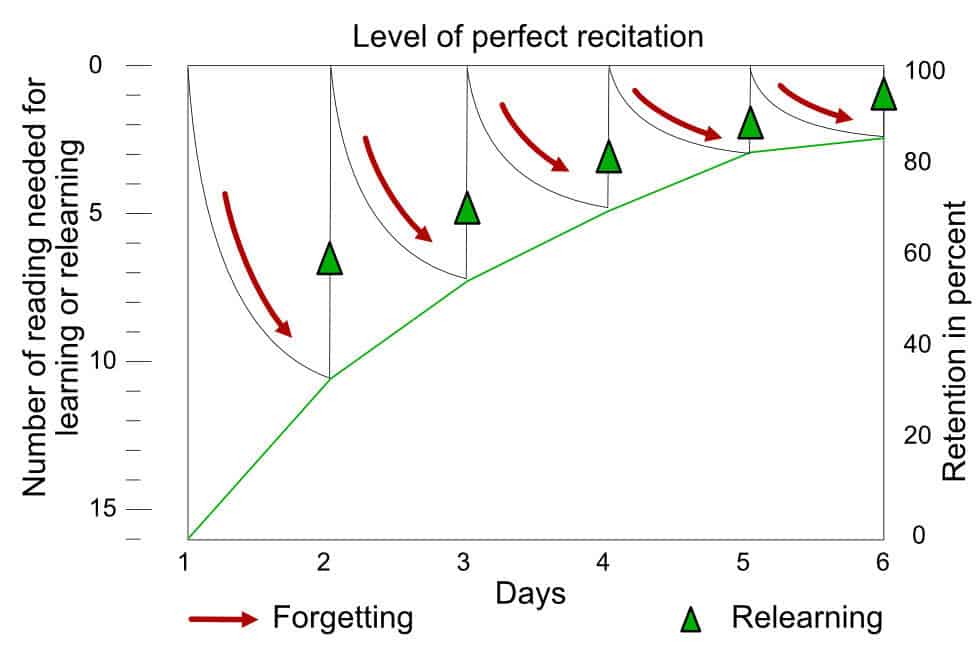Spaced repetition is a learning technique that involves reviewing material at increasing intervals of time. It is based on the idea that humans are more likely to remember something if they review it at progressively longer intervals. This is because spacing out reviews allows time for the information to be transferred from short-term memory to long-term memory, which is more stable and less susceptible to forgetting.
According to the German psychologist Herman Ebbinghaus, when you stick to a regular repetition cycle, you can slow down the forgetting decay and achieve the inverse of it – the learning curve – over time as shown in the graphical representation below.

How does spaced repetition work?
- Initial learning: When you first encounter new material, you will likely need to review it frequently in order to commit it to memory. This initial learning phase is important because it establishes a foundation of knowledge that you can build upon.
- Reviewing at increasing intervals: After you have learned the material, you can start spacing out your reviews. For example, you might review the material once the next day, then again in a week, then in a month, and so on. The intervals between reviews should gradually increase as you become more familiar with the material.
- Adjusting review intervals based on performance: As you review the material, you should pay attention to how well you are able to remember it. If you are able to recall the information easily, you can lengthen the intervals between reviews. If you struggle to remember the material, you may need to review it more frequently.
- Consolidating knowledge: As you continue to review the material at increasing intervals, it will become more deeply ingrained in your long-term memory. This process is called consolidation. The more you review the material, the stronger the connections in your brain will become, and the more likely you will be to remember it in the future.
Benefits of spaced repetition
There are several benefits to using spaced repetition in your study routine:
- Increased retention: Spacing out your reviews can help you retain information for longer periods of time, as the gaps between reviews allow time for the information to be consolidated in your long-term memory.
- More efficient use of time: With spaced repetition, you can review material more efficiently because you don’t have to spend as much time reviewing material that you already know well. Instead, you can focus on the material that you struggle with the most.
- Greater flexibility: Spaced repetition allows you to customize your study schedule to fit your needs and schedule. You can review material at your own pace and choose how often you want to review it.
Tools and techniques to use spaced repetition
There are several tools that you can use to incorporate spaced repetition into your study routine:
- Flashcards: One of the simplest and most effective tools for practicing spaced repetition is flashcards. You can create flashcards with a question on one side and the answer on the other. To use them, simply review the question and try to recall the answer from memory. If you can’t remember the answer, you can flip the card over to check. You can then decide how often to review each card based on how well you remember it.
- Spaced repetition software: There are also several software programs designed specifically for practicing spaced repetition. These programs allow you to input the material you want to learn and then schedule review sessions for you based on your progress. Some popular spaced repetition software programs include Anki and SuperMemo.
- Review sheets: Another option is to create a review sheet with a list of the material you want to learn. You can then review the sheet at increasing intervals, checking off each item as you go. This can be a simple and effective way to practice spaced repetition, particularly if you prefer a more traditional approach to learning.
- Practice tests: Another way to use spaced repetition is to take practice tests on the material you are learning. After you take a practice test, you can review the questions you missed and try to understand why you got them wrong. This will help you identify any areas where you need to focus more of your study efforts.
By using one or more of these tools, you can effectively incorporate spaced repetition into your study routine and improve your retention of the material you are learning.
